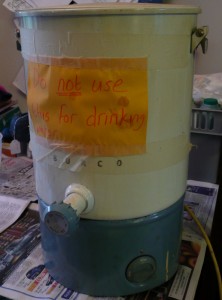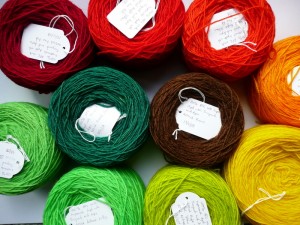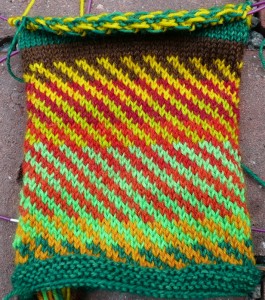I borrowed the Baby Burco owned by the West Surrey Guild of Spinners, Weavers and Dyers and have been having an experiment with dyeing solid colours. This is for my next City and Guilds project. Each project has to be inspired by a different one of our art modules, line, colour, texture, shape, and form. My cardigan was inspired by the module on line, and my next project is going to be inspired by the module on colour. There are four projects we need to complete in total, but we can do them in any order we like. Two are garments, a jumper with set-in sleeves, and a jacket or cardigan with sleeves which are not set-in. Both garments must display different necklines. Then there is an accessory and an item for interior use. I am planning to do the jumper with set-in sleeves next, and have been collecting pictures of autumn leaves for my inspiration.
Here is the Baby Burco in action.
I also bought some pH testing strips to test the pH of the dye solutions I was mixing. The The Dyer’s Companion (Companion (Interweave)) says that I should be aiming for a pH of between 4.5 and 5, and as you can see from the strip below, I had a pH of about 2, which could explain a lot of things. I have been doing some more experimenting with how much citric acid I use, and reckon that actually you need relatively little to create the appropriate pH. Citric acid is actually more acidic than acetic acid (vinegar).
I used 4ply weight superwash Bluefaced Leicester wool, and dyed 100g of each colour to give me plenty to play with. My idea is to knit up some samples and try out different colour combinations to see what I like. I don’t have firm ideas yet of what I am doing, so am hoping that doing a few knitted samples will give me some thoughts. It could well be that some of these colours wont be used in the final garment, and that I might add in some others, but at least this is a start. I dyed 10 colours for my first go.
I had quite a lot of trouble dyeing the kind of orange I had first been aiming at. You need a surprisingly small amount of red dye in with the yellow. I do like the couple of much darker oranges too though, and am looking forward to experimenting with all the colours.
I have started a little knitted sample but haven’t got very far yet.
I’m afraid it has been rather dark here, and the colours haven’t come out properly. The paler green near the bottom isn’t mint at all, but rather a paleish grass green. The 2×2 spiral idea is from Janine Bajus, she calls is speed swatching, and it is a nice quick way to get an idea about whether colours look reasonable together or not, without having to worry about the pattern. If you cast on 4n – 1 sts (where n is any whole number) then it will all spiral automatically with no effort whatsoever 🙂 In this case n = 20 so I cast on (4 x 20) – 1 = 79 sts. Big enough to get a proper look at how the colours are coming out, but small enough not to take forever. My plan is to do a few of these speed swatches, or perhaps just one long one, to give me some ideas for colour combinations. Then to work out possible patterns and try them in the most likely of the colour selections.
I started this on Sunday at our City and Guilds class, it was good to have other people’s input, and I agree with Fiona that this brown isn’t right, and that a redder brown would look better. I’m not yet sure whether I want a brown at all though, or whether I will have the darkest colour be the dark red, so I think I will do a bit more swatching and thinking before I dye any more colours.
Talking of Sunday, I got my cardi back from assessment and it is all fine (whew!) though I do need to make sure to do more art, and fewer photographs for the next projects.




Your colours look great- very saturated and all lovely. Can you see a difference when the ph is higher? The colours do look better.
The City & Guilds certainly makes you very disciplined and organised. When I dye it is complete pot luck! Your colours look fab and I love the spiral swatch. I shall have to check out the PH, thanks for sharing that.